Qt X Logic I/O functions overview
Qt X controller logic input and output settings allow users to configure actions in both the controller and in connected third-party devices. Logic I/Os either trigger an action as an input within the Qt X or trigger an output to the third-party external device. All Qt X controllers share the same available Logic I/O functions and wiring topology.
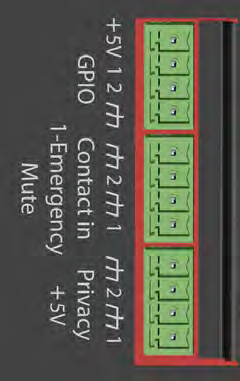
- Contact Inputs (Push to Talk & Emergency Mute)
- Privacy Sign Outputs
- Two Assignable GPIO Contacts
Logic Overview
Privacy 1 & 2
These outputs are for light panels used to indicate sound masking status in a zone. These do not have any audio functions or priority there are no overrides for the Privacy Light function. The Privacy Lights may only be set to activate or off. The privacy lights activate in the selected zone when the following are true.
- Sound Masking is enabled
-
Sound Masking is not set to mute
-
Sound Masking is set to higher than -20dB
GPIO (IO1 & IO2)
The general-purpose port inputs and outputs are used to select appropriate audio devices assigned in the Audio Sources tab. 'Unassigned I/O' will select by default.
-
Users have the option to select Mute and Talk Now from the drop-down if left assigned as an Output (Input not selected)
-
If selected as an Input, the drop-down selections change to Mute and Push to Talk.
-
Selecting Active Low is always available on the GPIO ports.
-
Priority may be changed for a zone or multiple zones.
-
Selecting Mute will disallow selection of an Audio Source, as this functionality mutes all audio in the selected zones.
-
Push to Talk is a paging microphone function and is therefore set automatically as an input (not editable).
-
Users may select the audio source type from the drop-down (assigned in the tab).
-
Priority may be changed for a zone or multiple zones.
-
- Emergency Mute is a dry contact closure and selectable only in an Active Low state. A Fire contact will propagate to all controllers in a system when activated from this port.
Settings locations
The I/O logic settings can be accessed in the Qt X system management software's Devices tab and also in each controller's onboard web user interface under the Logic I/O tab.
Web UI Qt X Software application
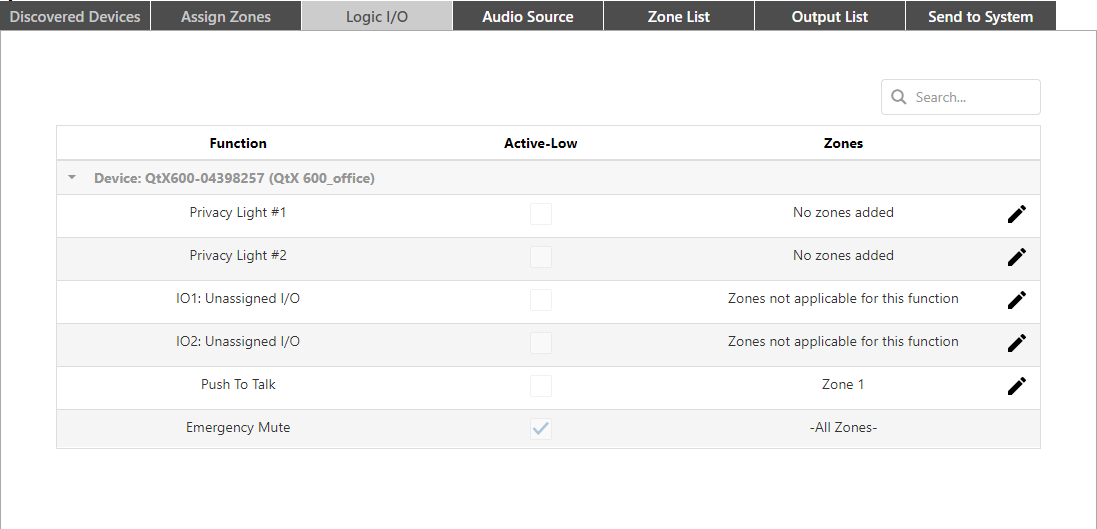
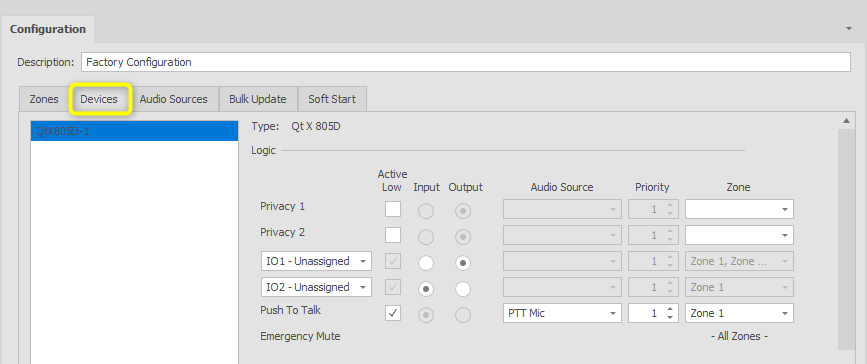
General Purpose Input Outputs (GPIO)
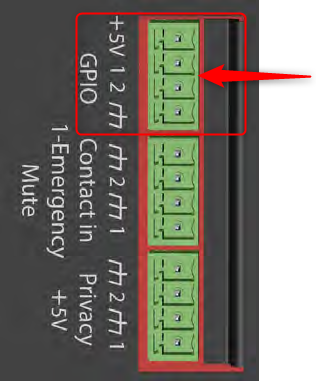 These logic port connections can be configured as inputs or output triggers in either "Active Low" or "Active High" states. This is useful for applications where events may be triggered to offer functionality inside Qt X (as an Input) or indicate a condition within Qt X (as an Output). Un-checking the "Active Low" box results in an "Active High" state.
These logic port connections can be configured as inputs or output triggers in either "Active Low" or "Active High" states. This is useful for applications where events may be triggered to offer functionality inside Qt X (as an Input) or indicate a condition within Qt X (as an Output). Un-checking the "Active Low" box results in an "Active High" state.
Input Mute Function
When connected and set to Active Low, any selected zone will mute all audio (sound masking, background music, and paging sources) on a contact closure. In other words, when the circuit is closed.
For example, in the following Active Low example, all audio is muted in Zones 1 through 3 when the circuit is closed.
Input Push to Talk
When connected and set to Active Low, the audio source chosen in the Source field will be sent to all selected zones when the contact is closed. In the example below with the Paging Station source selected for the Push to Talk input, this will mute the background music in Zones 1 through 3 when the contact is closed.
Although use cases are limited, changing the state to 'Active High' (Active Low not checked) routes the selected audio source to the selected zone when the contact is open.
In the state shown below, when the circuit is closed, audio will stream to the selected zones:
PTT paging level may then be adjusted per zone via the "zone data" tab. Verify that proper input gain and phantom power (if required) is enabled on the paging microphone input.
Output Talk Now
When selected as an output, this function provides a push-to-talk status indicator (contact input #2) or any available IO port that has been configured as an Input - Push to Talk. The associated port is determined by the selected device listed in the Audio Source dropdown. This functionality can indicate that a person may speak into a microphone by illuminating an LED (+5 VDC) when a specific push-to-talk contact is active.
Connect Pin 1 or 2 (depending on the IO output port) and Ground. If the setting is in an 'Active High' state, the connected LED will illuminate when the associated push-to-talk input is active. Selecting 'Active Low' will provide +5 VDC to the Talk Now output port when the associated Push to Talk input is inactive, thus indicating a paging microphone standby condition.
Output Mute
This function indicates the GPIO Input Mute condition is present in a specific zone. When in an 'Active High' state ('Active Low' unchecked,) a mute initiated by the GPIO input on any of the selected zone(s) will result in +5 VDC across pin 1 or 2 (depending on the output port) and the ground.
If the output is set to 'Active Low,' this will indicate the selected zone is not muted.
Although the practical use cases are limited, setting the Mute to Active Low will result in all zones being muted unless the signal is closed.
Contact closures
The Qt X provides a mute capability for masking and/or audio via contact closure.
Emergency Mute - position 1
Configured for Fire or Emergency panel input. The contact closure utilizes the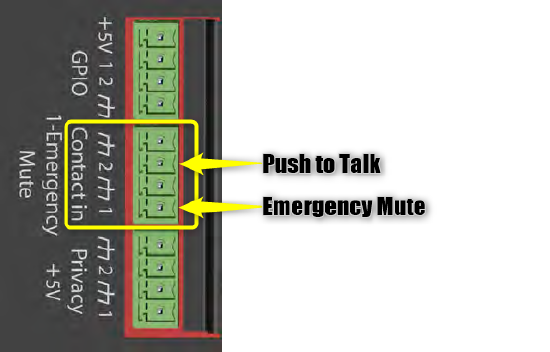
same style green euroblock connector as the privacy lights and GPIO (4-pin). This contact closure is hard coded to shut off all masking and audio outputs to the speakers as an "emergency mute". To instantly mute sound masking and sources, connect a two-conductor cable to the two contact closure connectors, labeled (1-Gnd).
Push to Talk - position 2
Configured to use this feature with audio, configured as Push-to-Talk (Input 2 only). When an incoming contact is closed (Active Low) the audio source shown will be sent to all zones selected in the Zone drop-down. This mutes any background music in the selected zones. Paging will occur in the same zones at the level selected from the zones tab (paging). To enable PTT, connect a two-conductor cable to the two connectors, labeled (2-Gnd).
A bus toggles between the background music and the paging. To hear or adjust paging levels, the contact must be closed (a connected paging mic live) and adjustments made to the paging level in the appropriate zone.
Push-to-talk behavior on contact two is identical to the GPIO push to talk functionality, though active low is the only option. If active high is required, the GPIO contact can be programmed.
Note: The contact closure sensing on position 2 is expecting a low level voltage in the range of 0.8v to trigger the logic. In some cases the push to talk microphone in use in the application will have a circuit that produces a higher level which fails to trigger the logic high. In these use cases, it is recommended to use the GPIO inputs which have a higher sensing range when in the closed state. The contact in connection works best with true contact closure switch type applications.
IMPORTANT: When a Qt X system comprised of multiple controllers is configured and connected via a network connection, only one "emergency mute" connection is required to a single controller location. A single contact trigger will propagate to all controllers included in the system.
Privacy signs
Two +5 VDC outputs are available to connect light panels indicating sound masking is active in a specific zone. Both Privacy 1 and Privacy 2 are connected and operate as follows:
Connect the positive lead of a privacy sign to pin 1 and the ground and/or pin 2 and ground if installing two signs while observing polarity. Select the Zone (one zone per output) from the software to associate with the privacy light indication. When sound masking is active in the associated zone (above -20dB) the associated privacy light will illuminate.
Priority
Priority determines if a page will preempt a page that is in progress. The lower the number, the higher the priority. Therefore a paging source set to Priority 1 will override any page set to Priority 2.
Note: The priority field can only be edited for GPIO 1 or GPIO2 when Push To Talk is selected. It can also be edited for the dedicated Push To Talk.




